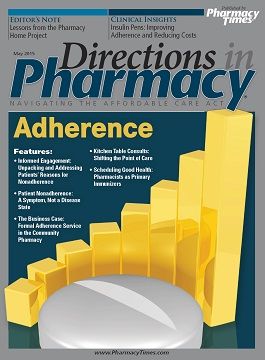Publication
Article
Pharmacy Practice in Focus: Oncology
The Appointment-Based Model: A Catalyst for Expansion of Services
Author(s):
An efficient pharmacy system allows pharmacists the time to provide valuable patient care services.
An efficient pharmacy system allows pharmacists the time to provide valuable patient care services.
Although the appointment-based model (ABM) is frequently cited within the context of medication synchronization as a cornerstone for improving adherence, the efficiencies inherent in the model also afford pharmacies the time and resources to drive quality improvement through the delivery of many other highly valuable patient care services. Using the ABM, pharmacies are able to deliver high-quality, cost-effective, patient-centered care to meet the demands of a changing health care landscape and ensure the sustainability of community pharmacy practice.
Quality Improvement
According to the Institute of Medicine, the United States’ recognized advisor on health care improvement, the quality of an organization is measured by the direct correlation between its health care services and desired health outcomes of individuals and populations. To improve quality, organizations must incorporate 4 key principles: systems approach, patient focus, team-based care, and data utilization.1 The ABM encompasses these 4 elements:
- Systems approach. Structured proactive patient contact in advance of the monthly patient visit, informational patient-level review and planning, and pre-visit contact with the patient to confirm objectives for the monthly patient visit are provided.
- Patient focus. The ABM shifts focus from prescription transactions to the holistic assessment of patient medication and health care—related needs. These needs are addressed longitudinally by virtue of multiple monthly touch points in preparation for pharmacist–patient engagement at the monthly visit.
- Team-based care. The ABM positions pharmacy to provide a broader mix of patient care services and improve the coordination of care required to function as an active member of the health care team.
- Data utilization. Central to the effective ABM is technology that provides actionable data for efficient identification of patients on whom the pharmacy should focus and the necessary interventions/ services that the pharmacy should provide.
The Changing Health Care Environment
Unsustainable health care costs continue to drive an intense focus on value.2 Health care quality, safety improvement, and cost reduction have become health care imperatives.3 Health plans and health care providers are assuming increasing levels of risk. In order to navigate successfully, they are aligning with new partners, utilizing more data in different ways, and prioritizing value in health care decision making.2 In addition, the aging US population and tremendous advances in health care technology have continued to increase the demand for pharmacy services.3
According to a 2014 report, Exploring Pharmacists’ Role in a Changing Health Environment, increased health care costs have typically not resulted in quality improvements: they may be related to inefficiencies and variation in care delivery. The Joint Commission of Pharmacy Practitioners’ 2014 publication, The Pharmacists’ Patient Care Process, underscores the need to minimize inefficiency and variation by advocating for a standardized patient-centered pharmacy process in a collaborative, team-based approach with other health care providers to optimize patient health and medication outcomes.4 The ABM affords pharmacy a framework within which to achieve the standardization and efficiency required to not only tackle nonadherence, but also improve health care quality and decrease related costs.
Greater access to data yields information that can facilitate quality improvement, cost savings, and collaboration among providers. To benefit from this data, pharmacies need technology and data analytics to not only access the information, but to filter actionable information from noise in order to capitalize on 3 trends that are shaping the health care market today2:
- Health plans are seeking savings through partnerships, integration, and provider risk sharing.
- Providers are focused on higher value service delivery, coordination of care, and team-based collaboration
- Patients are more engaged due to improved access to health plan and provider ratings, true costs of care, and their own health care information.
Pharmacy Expansion of Patient-Centered Care
Health plans, providers, and patients rely increasingly on the ability of pharmacy to continue to migrate from a traditional dispensing function to the delivery of patient care services. This movement is reflected in the recently released 2014 National Pharmacist Workforce Survey, where 35% of respondents who practice in community pharmacy settings reported spending much more time providing patient care services unrelated to medication dispensing over the past year. The most common services offered at respondents’ practice sites were medication therapy management (60%), immunizations (53%), adjusting medication therapy (52%), and health screenings (48% and 57% by chain and grocery respondents, respectively).3
Services unrelated to medication dispensing are being provided by pharmacies at varying levels based on multiple factors including pharmacist authority/ scope of practice, population needs, patient demographics, payer opportunities, and practice sites, among others. Technology, systems integration, data flow, and sound implementation strategies are enabling pharmacies to transition to the ABM, which facilitate expansion of patient care services via a standardized patient care process. These services include:
- Medication management. Although many published studies show significant benefits of pharmacist-provided medication management, of which medication therapy management (MTM) is the most commonly provided of all patient care services listed here, widespread adoption has not materialized. MTM programs currently have a low nationwide comprehensive medication review (CMR) completion rate of about 11%.5 Meanwhile, researchers have proven that face-to-face delivery of MTM services is 3 times more effective than telephonic communication.6 More widespread adoption of the ABM model in community pharmacies is needed to enable successful execution of higher rates of CMR and targeted medication review completion due to the longitudinal, monthly pharmacist— patient engagement.
- Comprehensive patient care programs. These programs are similar to MTM, but include focused, high-touch, longitudinal management, with emphasis on closure of treatment gaps, in addition to medication and health condition education for both traditional chronic diseases and specialty conditions, such as rheumatoid arthritis, HIV, and hepatitis C. The longitudinal, high-touch nature of comprehensive patient care programs is very well suited to the ABM model.
- Immunization. Pharmacists are highly effective in vaccine administration and have significantly increased vaccination rates. The ABM process supports proactive identification of patients with vaccination gaps and the pre-visit offer to the patient of vaccination, and allows vaccination as part of the monthly visit to conveniently close gaps. Due to pharmacist success in increasing vaccination rates, it is anticipated that pharmacists’ will have an increased role in vaccine administration in the future.
- Health screenings. Studies have demonstrated that pharmacists can effectively deliver a variety of screening services. By virtue of their accessibility, front-line community pharmacists are very well suited to conduct health screenings, identify the presence of diseases earlier in their course, and communicate, as appropriate, with other health care providers. Pharmacy-based screenings include Clinical Laboratory Improvement Amendments—waived tests, such as blood glucose and cholesterol.
- Health coaching. Pharmacist health coaching and education to establish, reinforce, and sustain behaviors to effectively manage chronic diseases has been shown to yield improved patient health outcomes, provided concurrent with other pharmacist services and in isolation.7 Smoking cessation and weight management are 2 areas where face-to-face pharmacist education and behavioral counseling have been proven beneficial in assisting patients with achieving their health goals.8
- Point-of-care testing. Point-of-care testing (POCT) is testing done in proximity to the patient rather than in a remote laboratory. Depending upon state regulations, pharmacies may perform POCT for glycated hemoglobin, lipid panels, liver function tests, etc, as part of ongoing chronic care management. Rapid diagnostic testing (RDT) is the subset of POCT that can be used to influence treatment decisions by determining the probability of presence or absence of disease. RDT is available for influenza, group A streptococcus pharyngitis, HIV, and hepatitis C, and may be included as part of a pharmacy’s outpatient infectious disease management/stewardship programs.9
- Transitional care. The Centers for Medicare & Medicaid Services’ hospital readmission reduction program assesses penalties to hospitals for excessive unplanned 30-day readmissions for heart attack, heart failure, chronic obstructive pulmonary disease and pneumonia. In addition, health plans are evaluated via an all-cause readmission measure in the Healthcare Effectiveness Data and Information Set. Community pharmacists have shown an ability to prevent unplanned hospital readmissions through the provision of medication reconciliation, efforts to ensure receipt of appropriate discharge medications, and patient check-in calls, as appropriate, during the course of the first 30 days after discharge. Community pharmacy collaboration has proven beneficial to both health plans and hospitals.
Summary
The expansion of the role of the pharmacist and the services offered by pharmacies will continue in scope and demand, including medication management, medication reconciliation, immunization, health screenings, patient education regarding medications and health conditions, and behavioral counseling. Technology, systems integration, data flow, and sound implementation strategy are enabling pharmacies to make this transformation and capitalize on the ABM as the vehicle to deliver positive, reproducible, and scalable results aimed at quality improvement.
Rebecca W. Chater, RPh, MPH, FAPhA, has been a career-long pioneer in innovative community-based clinical pharmacy practice. Chater is the executive health care strategist for Ateb, Inc, a leading provider of appointment-based model solutions for pharmacy. Throughout her career, Chater has championed the pharmacist as a medication expert, integral to the health care team in solving the systemic problems of medication use that compromise quality and place enormous economic burden on our nation’s health care system.Chater’s career in pharmacy spans many settings: community practice, medical practice, academia, long-term care, and specialty pharmacy. In the late 1990s, she led North Carolina’s Kerr Drug to national prominence for innovation by spearheading Kerr’s foray into community pharmacy—based clinical services utilizing an appointment-based model, including the Asheville Project.Chater is a past trustee and fellow of the American Pharmacists Association and has received numerous state and national awards for professional leadership and innovation.
References
- US Department of Health and Human Resources, Health Resources and Services Administration. Quality Improvement. April 2011. www.hrsa.gov/quality/toolbox/methodology/qualityimprovement.
- Exploring Pharmacists’ Role in a Changing Healthcare Environment. Washington, DC: Avalere Health; May 2014. http://avalere.com/expertise/life-sciences/insights/exploring-pharmacists-role-in-a-changing-healthcare-environment.
- Midwest Pharmacy Workforce Research Consortium. 2014 National Pharmacist Workforce Survey. Pharmacy Workforce Center. April 8, 2015. www.aacp.org/resources/research/pharmacyworkforcecenter/Documents/ExecutiveSummaryFromTheNationalPharmacistWorkforceStudy2014.pdf
- Pharmacists Patient Care Process. Joint Commission of Pharmacy Practitioners. May 29, 2014. www.accp.com/docs/positions/misc/JCPP_Pharmacists_Patient_Care_Process.pdf.
- Beginning of movement toward better outcomes: what GlaxoSmithKline’s marketing decision means for MTM. Censeo Health website. www.censeohealth.com/blog/movement-toward-better-outcomes.
- Boylan L. NEHI releases new report on medication adherence. National Association of Chain Drug Stores web site. February 8, 2013. www.nacds.org/Home/3397/2013-02-08/nehi-releases-new-report-on-medication-adherence.
- Kraemer DF, Kradjan WA, Bianco TM, Low JA. A randomized study to assesss the impact of pharmacist counseling of employer-based health plan beneficiaries with diabetes: the EMPOWER study. J Pharm Pract. 2012;25(2):169-79. doi: 10.1177/0897190011418513.
- Patwardhan PD, Amin ME, Chewning BA. Intervention research to enhance community pharmacists’ cognitive services: a systematic review. Res Social Adm Pharm. 2014;10(3);475-93. doi: 10.1016/j.sapharm.2013.07.005.
- Klepser ME, Dering-Anderson A. CLIA point of care testing for managing infectious disease [presentation]. American Pharmacists Association Annual Meeting; San Diego, CA. March 2015.







